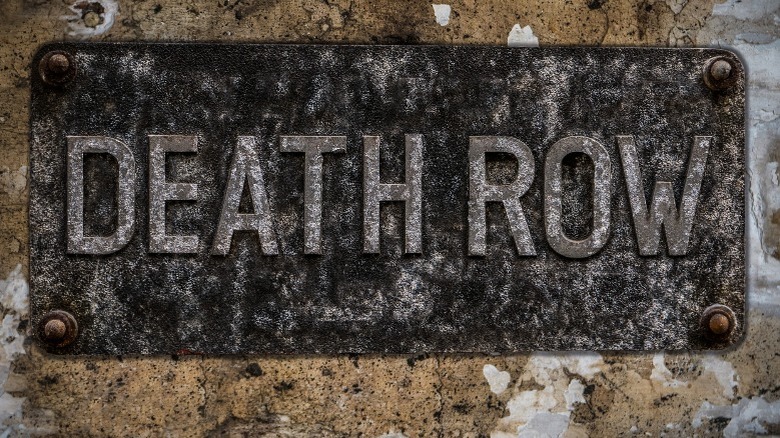How Many People Did Henry Louis Wallace Really Kill?
Convicted serial killer Henry Louis Wallace was born to a single mother in Barnwell, South Carolina. His mother, Lottie Mae Wallace, had been having an affair with a married school teacher, who promptly left her and her unborn child to fend for themselves the moment she revealed her pregnancy to him (per Murderpedia). Wallace's mother provided for him and his older sister the best she could, but her low-paying job at a local textile mill didn't yield much income. The family was forced to live in a small home with no indoor plumbing or electricity (via ThoughtCo), quarters they shared with Wallace's great-grandmother.
Wallace's mother was very strict, and she was especially hard on her young son. He was sometimes forced to walk around the neighborhood in his older sister's clothing as punishment (via Crime Magazine). Other times, she would make Wallace and his sister whip each other with switches that they were forced to cut from nearby trees. But despite his home life and without a familiar father figure in his childhood, Wallace was well-liked in high school. He was elected to the student council and was his high school's only male cheerleader. Even though his academics weren't the best, he was admitted into South Carolina State College (where he attended one semester) and to a technical school that he briefly attended.
While in college, Wallace began to get into trouble. It began with a newly developed habit of stealing, which after several years evolved into rape and murder.
He began his criminal career with petty theft
In college, Henry Louis Wallace worked as a disc jockey at a local radio station. According to Crime Magazine, he was fired from the station after being caught stealing records. With his options limited, Wallace joined the Naval Reserve shortly after his termination (via ThoughtCo). Things seemed to be looking up for Wallace at this point, especially after he married his high school sweetheart and became the stepfather to her daughter. The young family relocated to Washington state.
But within several years of joining the Navy, Wallace began experimenting with drugs. Eventually, he developed an addiction to crack cocaine. To get the money to pay for the drug, Wallace began breaking into homes and businesses to steal property that he could later pawn. These actions led to his eventual arrest and prosecution. Though convicted and placed on probation, Wallace was still able to get an honorable discharge from the Navy due to his near-perfect record as a serviceman.
Wallace found his way back to South Carolina after a divorce from his wife that almost immediately followed his discharge. He was forced to move back in with his mother, who had moved to the city of Charlotte. What his family and authorities did not know was that Wallace had already committed one murder just a year before his discharge. And he was just getting started.
If you or anyone you know is struggling with addiction issues, help is available. Visit the Substance Abuse and Mental Health Services Administration website or contact SAMHSA's National Helpline at 1-800-662-HELP (4357).
Many of his victims were known to him
Henry Louis Wallace's first victim was Tashonda Bethea in 1990. When visiting his hometown of Barnwell, he strangled her and dumped her body into a nearby lake. As he was familiar with the victim, he was questioned by police about her murder weeks later after her body was found (per ThoughtCo). But without evidence, police couldn't charge him with the crime. In May of 1992, Wallace committed murder again. This time, the victim was a sex worker named Sharon Nance. Wallace picked her up and beat her to death after the two had sex (via Murderpedia). Her body was found several days later, but police did not connect Wallace to the murder.
ThoughtCo outlines how most of Wallace's remaining victims were women that were known to him. In June 1992, Wallace claimed his third victim, Caroline Love, who was his girlfriend's roommate. He let himself in with his girlfriend's key and lay in wait in the empty apartment for Love to return home. Once she arrived, he raped and strangled her. Her body was wrapped in an orange garbage bag and abandoned by Wallace in a ditch (per Crime Magazine).
Working primarily in the fast-food industry at this time, Wallace claimed the lives of his co-workers as well as the friends of his girlfriend. In February 1993, Wallace raped and killed Taco Bell co-worker Shawna Hawk. Another co-worker, Audrey Spain, was murdered by Wallace the following June.
If you or anyone you know has been a victim of sexual assault, help is available. Visit the Rape, Abuse & Incest National Network website or contact RAINN's National Helpline at 1-800-656-HOPE (4673).
Wallace targeted Taco Bell coworkers
Henry Louis Wallace preyed on women known to him, and the next life he took was a friend of his sister's, Valencia M. Jumper, in August 1993. ThoughtCo tells of how he tried to burn her corpse afterward. Several days after the murder, Wallace and his sister attended Jumper's funeral.
In September, Wallace raped and murdered another Taco Bell co-worker, Michelle Stinson, who was stabbed and raped in front of her oldest son. Several months later, yet another Taco Bell employee was the target of Wallace's cruelty — Vanessa Little Mack, a single mother of two, was raped and murdered in her apartment by Wallace in February 1994. In March, Wallace set his sights on another friend of his girlfriend, Betty Jean Baucom, and robbed her apartment afterward. That night, Wallace broke into the apartment of Brandi June Henderson and subjected her to the same treatment as Baucom. Wallace also strangled Henderson's son, but he was able to survive the attack.
Four days later, Wallace committed his last known murder — Deborah Ann Slaughter, who worked with Wallace's girlfriend, was stabbed 38 times and left to die. Wallace was arrested on March 13, 1994, and made admissions to police. Now it was up to authorities to determine the number of lives that Wallace took on his murderous rampage.
Wallace was convicted of nine murders
Henry Louis Wallace was arrested after police recovered a handprint that belonged to him in the vehicle of one of his murder victims. Under interrogation, Wallace admitted to the murders of 10 women, most of whom he had also sexually assaulted (via ThoughtCo). According to Crime Magazine, Wallace went on trial in September 1996, with a jury returning a verdict of guilty on January 7, 1997. He was found guilty of nine murders and sentenced to nine death sentences. Officially, nine is the death toll of Wallace, as he wasn't found guilty in the 1990 murder of Tashonda Bethea (per Murderpedia). But while incarcerated, Wallace admitted to additional murders. These admissions, if true, could put his total murder count up to as many as 20.
In 1998, Wallace married prison nurse Rebecca Torrijas, a woman 23 years his senior. The couple was wed in a room adjacent to the execution chamber that Wallace will one day sit inside and suffer the fate the state of South Carolina handed him. Wallace still lives today, awaiting his execution on death row in South Carolina. He exhausted all of his plea attempts, with the United States Supreme Court denying hearing an appeal in 2001; no execution date has been set.
Wallace didn't fit the FBI profile of a serial killer
Henry Louis Wallace breaks the mold of the typical serial killer. While many serial murderers come from impoverished backgrounds, that isn't necessarily a defining characteristic. Though Wallace shares the same childhood abuse traumas as is common with killers, the remaining boxes on the profile checklist aren't all checked. The Charlotte-Mecklenburg Police Department, believing that they had a serial killer on their hands, turned to the FBI for help in early 1994. But the agency looked at the evidence and Wallace and declared that the murders were not the work of a serial killer. According to Crime Magazine, serial killer expert and FBI agent Robert Ressler testified during Wallace's trial. Ressler stated: "If he (Wallace) elected to become a serial killer, he was going about it in the wrong way."
This holds when comparing Wallace to the serial killer profile. Wallace, an African American, did not fit the profile of the typical serial murderer, who is almost always caucasian. Additionally, the typical serial killer takes the lives of strangers and has a "type" that they work to eliminate. Wallace had no type, and every person he was convicted of killing was someone well known to him. In fact, many of these women had known him so well that they gave him a certain level of trust. Had the FBI become involved when they were first asked to by local police, the lives of Wallace's last several victims might have been spared.





